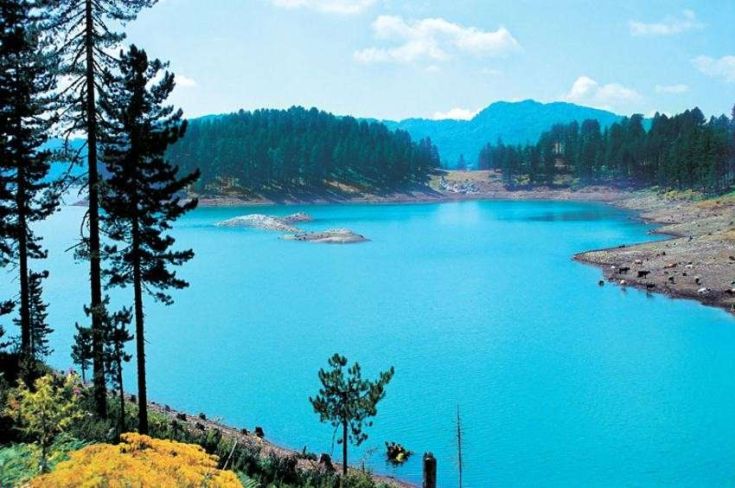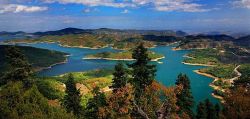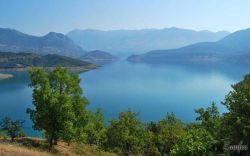We present you the lakes that will have the opportunity to admire those who will participate in the race of Bike Odyssey:
Aoos Lake
Aoos Lake is an artificial lake which was created after a dam construction on the Aoos River. It is located in the prefecture of Ioannina, about 20 km northwest of Metsovo. It has an area of approximately 11.5 square kilometers, at an altitude of 1.350 meters, which classifies it as the most mountainous large lake in Greece and is surrounded by seven dams. It was built in 1987 on the Politses Plateau, in order to produce electricity, but then it was a very important biotope for the area. The waters of the lake, which have been enriched with fish and are subjected to limited amateur fishing, are channeled to the Metsovitikos River at the height of Chrysovitsa.
It is located between two National Parks, Valia Calda and Vikos-Aoos and is a true travel experience. The islets and the fjords in its interior compete in beauty with the dense forests with the beech trees reaching almost to its shores.
The vegetation around the lake is unique, both in terms of beauty and in terms of many rare plants. At the east of the lake, as the mountainous volumes begin to rise, forests of black pine and scattered rocky are prevailing, while at the west begins one of the largest and most beautiful beech forests of Greece. In the meadows there are scattered trees and shrubs, such as hawthorns and hornbeam. Next to the streams dozens of species of rare orchids grow, while in spring the meadows are overwhelmed by wild daffodils and other plants. The avifauna includes many species of forest and wading birds. At the area impressive and rare birds live permanently or occasionally. Mammals include many miraculous animals. Frequent is the presence of bears, wolves, wild cats, deer, foxes, badgers, ferrets, hares and tree-mongers. The contact with the natural environment and the scenery of rare beauty compensates the traveler who will reach the lake, with Pindus peaks to "tear" the horizon. In winter it is very likely that everything is covered in white, composing a unique mosaic of snowy images.
Plastiras Lake
Plastiras Lake is a lake located on the plateau of Nevropolis in the Prefecture of Karditsa. It is an artificial lake and its official name is Lake Tavropou. It contains 400 million cubic meters of water, it has a maximum length of 12 kilometers, a maximum width of 4 kilometers, its total surface is 24 square kilometers, its maximum depth is about 60 meters and its maximum altitude is 750 meters.
It was formed in 1959 with the completion of the dam at the south end of the River Tavropos or Megdovas, and the idea of its construction was attributed to the military and political Nicholas Plastiras when in 1935 he visited his hometown which had catastrophic floods in the region and Macedonia from constant rainfall. When he saw the site is said to have said that "here one day will become a lake", from which its most famous name: Plastiras Lake.
The scenery is exciting as the beautiful lake is embraced by high green mountains, while the area is considered a "paradise" for all nature lovers, as it provides the opportunity for mountaineering, fishing, exercise in all kinds of mountain sports and forest walks.
Since the early 1980s, thousands of nature and folk culture lovers have discovered the beauty of the region and its uniqueness. The dozen operators and private investments, over the last decade, have turned the lake area into a sought-after tourist destination and attracting thousands of visitors all year round.The road around the lake offers magical images.
Mornos Lake
An artificial lake created by the waters of the Mornos River and embraced by two large mountains, stands in the heart of Roumeli, offering protection and food to many species of fauna. Mornos Lake was built to meet the need of Athens water supply and was completed in 1981 with the construction of a dam on the Morno River, which is one of Europe's largest dams. It is situated at an altitude of 500 meters, its total surface is about 15 square kilometers and its perimeter reaches 70 km. The lake forms a large X in the center of the prefecture of Phocis, covering with its waters a basin west of Lidoriki, between Giona Mountain and Vardousia mountains. It gathers water not only from Mornos but also from its tributaries, most notably the Kokkinopotamos, which originates from the Vardousia, while, through a tunnel, there are waters coming from the lake of Evinos. Mornos Lake is a great aquatic ecosystem among plains, high mountains and wooded hills that gather a host of wildlife and plants.
The Mornos aqueduct carrying the lake water to Attica is one of the largests in Europe with a total length of 188 km. It crosses the prefectures of Phocis, Boeotia and Attica. 15 tunnels with a total length of 71 km have been built on this route.
The vegetation around the lake consists almost exclusively of Mediterranean maquis with large spruce forests from people reaching 20 meters.
The area is often visited by large birds of prey from the surrounding mountains, such as golden eagles, geraniums, fiesta, hazelnuts, golden jellyfish, bumble bees, owls and many more.
Generally, Mornos Lake is a rich ecosystem that manages to survive. Problems in the area are uncontrolled hunting with frequent killings of wolves and the frequent pollution of the lake by agricultural waste water.







